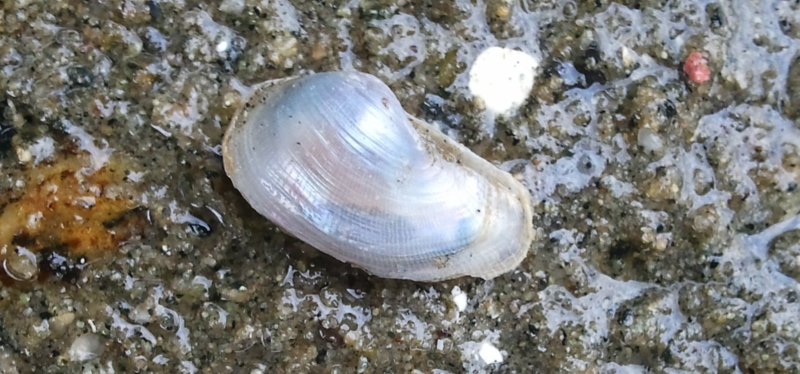Threaded pandora, western pandora • Pandora filosa
Identification
Like others of Family Pandoridae, the threaded pandora is small with a compressed shell and one shell valve more rounded than the other. The posterior end is squared and upturned (click here for information on shell orientation). The exterior white and the interior is pearly white. Maximum length is 2.7 cm.
Habitat & Range
Threaded Pandora is a subtidal species found in gravelly sediment to a depth of 300 m. Its range extends from central Alaska to northern Mexico.
Similar Species
This bivalve has a similar shape to bent-nose macomas and may be mistaken for a juvenile bent-nose macoma due to its small size.
Like others of Family Pandoridae, the threaded pandora is small with a compressed shell and one shell valve more rounded than the other. The posterior end is squared and upturned (click here for information on shell orientation). The exterior white and the interior is pearly white. Maximum length is 2.7 cm.
Habitat & Range
Threaded Pandora is a subtidal species found in gravelly sediment to a depth of 300 m. Its range extends from central Alaska to northern Mexico.
Similar Species
This bivalve has a similar shape to bent-nose macomas and may be mistaken for a juvenile bent-nose macoma due to its small size.
References
Harbo, R. M. (1997) Shells & Shellfish of the Pacific Northwest. Madeira Park, BC: Harbour Publishing. Pp. 176-177.
Lamb, A., and Hanby, B. (2005). Marine Life of the Pacific Northwest [electronic version]. Madeira Park, BC: Harbour Publishing.
Authors and editors of page
Kelly Fretwell, Jessica Brown, and Brian Starzomski (2014).
Harbo, R. M. (1997) Shells & Shellfish of the Pacific Northwest. Madeira Park, BC: Harbour Publishing. Pp. 176-177.
Lamb, A., and Hanby, B. (2005). Marine Life of the Pacific Northwest [electronic version]. Madeira Park, BC: Harbour Publishing.
Authors and editors of page
Kelly Fretwell, Jessica Brown, and Brian Starzomski (2014).




